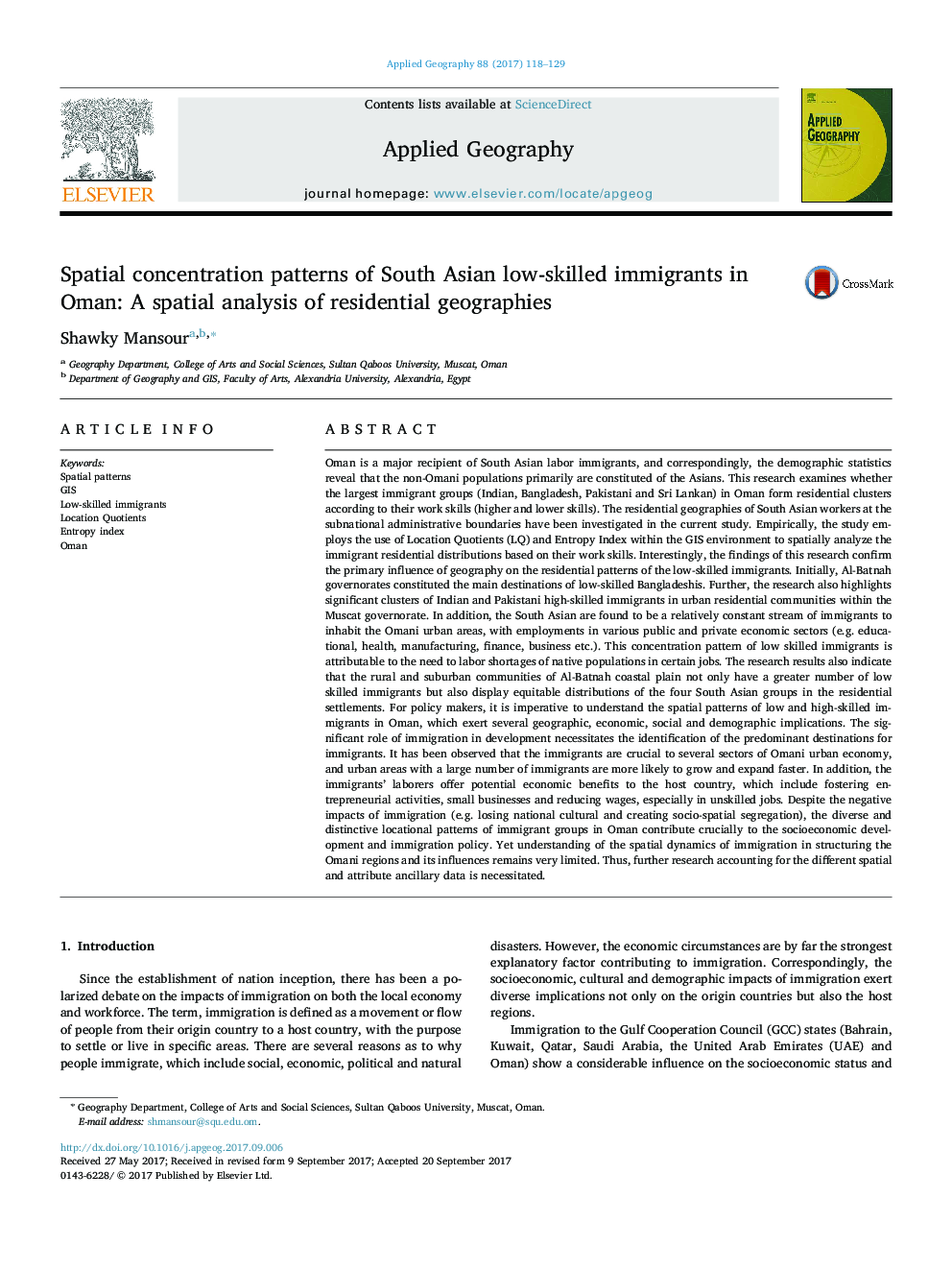| کد مقاله | کد نشریه | سال انتشار | مقاله انگلیسی | نسخه تمام متن |
|---|---|---|---|---|
| 6458292 | 1421029 | 2017 | 12 صفحه PDF | دانلود رایگان |
- Recently, the number of immigrant population has significantly increased in Oman.
- The majority of immigrants are South Asian and poorly educated with low skills.
- Location Quotients and Entropy indices were utilized to examine spatial concentration patterns of South Asian immigrants.
- Low-skilled immigrants concentrate across the urban coastal areas of Muscat and Al-Batnah governorates.
- A significant diversity pattern of low-skilled South Asian groups was identified across rural and suburban communities.
Oman is a major recipient of South Asian labor immigrants, and correspondingly, the demographic statistics reveal that the non-Omani populations primarily are constituted of the Asians. This research examines whether the largest immigrant groups (Indian, Bangladesh, Pakistani and Sri Lankan) in Oman form residential clusters according to their work skills (higher and lower skills). The residential geographies of South Asian workers at the subnational administrative boundaries have been investigated in the current study. Empirically, the study employs the use of Location Quotients (LQ) and Entropy Index within the GIS environment to spatially analyze the immigrant residential distributions based on their work skills. Interestingly, the findings of this research confirm the primary influence of geography on the residential patterns of the low-skilled immigrants. Initially, Al-Batnah governorates constituted the main destinations of low-skilled Bangladeshis. Further, the research also highlights significant clusters of Indian and Pakistani high-skilled immigrants in urban residential communities within the Muscat governorate. In addition, the South Asian are found to be a relatively constant stream of immigrants to inhabit the Omani urban areas, with employments in various public and private economic sectors (e.g. educational, health, manufacturing, finance, business etc.). This concentration pattern of low skilled immigrants is attributable to the need to labor shortages of native populations in certain jobs. The research results also indicate that the rural and suburban communities of Al-Batnah coastal plain not only have a greater number of low skilled immigrants but also display equitable distributions of the four South Asian groups in the residential settlements. For policy makers, it is imperative to understand the spatial patterns of low and high-skilled immigrants in Oman, which exert several geographic, economic, social and demographic implications. The significant role of immigration in development necessitates the identification of the predominant destinations for immigrants. It has been observed that the immigrants are crucial to several sectors of Omani urban economy, and urban areas with a large number of immigrants are more likely to grow and expand faster. In addition, the immigrants' laborers offer potential economic benefits to the host country, which include fostering entrepreneurial activities, small businesses and reducing wages, especially in unskilled jobs. Despite the negative impacts of immigration (e.g. losing national cultural and creating socio-spatial segregation), the diverse and distinctive locational patterns of immigrant groups in Oman contribute crucially to the socioeconomic development and immigration policy. Yet understanding of the spatial dynamics of immigration in structuring the Omani regions and its influences remains very limited. Thus, further research accounting for the different spatial and attribute ancillary data is necessitated.
Journal: Applied Geography - Volume 88, November 2017, Pages 118-129
